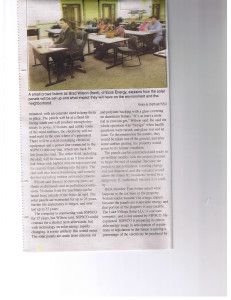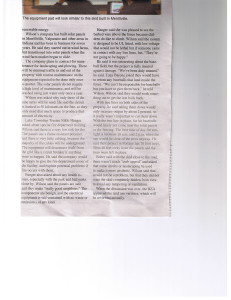A photo illustration shows what will be the first phase of a solar farm now under construction at Indianapolis International Airport. / Telamon Corp.
http://www.indystar.com/article/20130420/BUSINESS/304210015/Indianapolis-solar-farms-taking-off
Utility's incentives, cheaper panels spur surge of alternative energy projects in Indianapolis
Written by Carrie Ritchie, Apr 20, 2013
The first phase of Indiana’s largest solar farm is under construction at Indianapolis International Airport. The airport announced a second phase Friday. And sizable farms have been proposed for land near the Indianapolis Motor Speedway and along Southport Road on the Far Southside.Indianapolis might not have Florida’s reputation for sunshine, but it’s quickly becoming a hub for solar energy![]() .
.
Construction could begin on 31 large farms this year, and several smaller projects at homes and businesses![]() are in the works, according to Indianapolis Power & Light, which keeps track of the projects.
are in the works, according to Indianapolis Power & Light, which keeps track of the projects.
If all of the projects are built, the energy they produce, coupled with energy produced by existing projects, would provide up to 100 megawatts of power per hour — enough to keep the lights and appliances running at 12,500 homes. Although that would account for only 1 percent of IPL’s power, it would be a significant increase compared with the amount generated elsewhere in Indiana and in neighboring states, IPL project engineer John Haselden said.
“One hundred megawatts of power in Indianapolis is probably more solar power than what’s in surrounding states combined,” Haselden said. “If they all get built, there would be quite a concentration of solar power.”
Some experts and activists question the cost and efficacy of solar, but it does offer several benefits.
The boom in Indianapolis presents a business![]() opportunity for companies that want to make use of unused land and rooftops. Solar power also could create hundreds of jobs and hundreds of millions in new construction projects.
opportunity for companies that want to make use of unused land and rooftops. Solar power also could create hundreds of jobs and hundreds of millions in new construction projects.
It’s too early to tell how large and how lucrative the solar industry might be here because the boom is still in its infancy. Whether it will continue will depend largely on two of the factors that made it possible: incentives from the government and utilities such as IPL, and the decreasing cost of solar panels. As long as the incentives keep coming and the price of panels keeps dropping, experts expect more solar farms to be built.
-------------------------------------------------------------------------------------------
Harvesting sunlight
Solar![]() farms are starting to pop up around Indianapolis, largely because of incentives Indianapolis Power & Light has offered to developers. Here are some of the biggest projects that could be completed later this year:
farms are starting to pop up around Indianapolis, largely because of incentives Indianapolis Power & Light has offered to developers. Here are some of the biggest projects that could be completed later this year:
1. Indianapolis International Airport: This single solar farm will be Indiana’s largest. The first of two phases is under construction![]() . Each will have about 40,000 solar panels and be capable of producing about 10 megawatts of energy per hour, enough to power about 1,200 homes.
. Each will have about 40,000 solar panels and be capable of producing about 10 megawatts of energy per hour, enough to power about 1,200 homes.
2-3. Southern Marion County: Sunrise Energy plans to develop farms on two lots at 10321 E. Southport Road and one lot at 5800 W. Southport Road. Combined, they will generate 28.6 megawatts of power per hour.
4. Indianapolis Motor Speedway: Blue Renewable Energy plans to develop a 25- to 30-acre solar farm on land east of the northern half of the Speedway. The farm would generate 9.6 megawatts of power per hour. IMS officials did not return phone calls seeking comment.
5. Vertellus: The chemical company plans a farm near its headquarters at 1500 S. Tibbs Ave. The farm would generate about 9 megawatts of power per hour.
Source: Indianapolis Power and Light
------------------------------------------------------------------------------------------
“They’re definitely going to start popping up here pretty soon,” said Nick Melloh, president of Indianapolis-based Johnson-Melloh Solutions, which is helping to develop the solar farm at the airport.
IPL’s incentives for large solar farms have run their course. They ended March 30, and the deadline likely contributed to the recent surge in projects.
IPL is trying to limit how many farms are coming in so its customers won’t see a spike in their monthly bills. IPL pays solar owners more per watt for what they produce than the rate it charges customers to use the energy. So if all of the planned projects are built, IPL customers might see their bills increase by a few cents each month, Haselden said. The company will monitor the impact of projects that are in development before deciding whether to continue providing incentives for larger solar farms.
“We’re trying to be cognizant of rates, while at the same time developing renewable energy,” Haselden said.
Why solar?
People are beginning to explore solar energy for reasons ranging from efficacy and cost to emotion and aesthetics.
Power companies are more eager to invest in alternative energy because of restrictions on coal. The Environmental Protection Agency is increasingly regulating carbon dioxide, which coal-burning power plants release into the air. Some states require power companies to use some alternative energy sources. Indiana doesn’t have a mandate, but companies here are beginning to explore options other than coal.
“Every good portfolio has a diversification piece to it, just like your own investment,” Melloh said. “You spread it out to more conservative investments to know that in the long haul it’s going to pay off.”
Solar works better in Indianapolis than other types of alternative energy. It’s not very windy in Indianapolis, Haselden said, and it’s hard to build the tall turbines in the city. Biomass, which sometimes involves extracting methane from animal waste, also hasn’t worked well here because there aren’t many farm animals in the city.
Solar energy systems are becoming more affordable, too. Installing a system on a home five years ago cost about $8 per watt of energy produced, said Bill Hutzel, professor of mechanical engineering technology at Purdue University. Now, home systems cost about $5 a watt. Most arrays at homes range from 1 kilowatt to 10 kilowatts, so they can cost as little as $5,000 or as much as $50,000.
Installing a larger farm could cost $3 to $4 a watt. A decade ago, the first phase of the airport project, which is expected to cost about $30 million, likely would have been at least twice as expensive to build, Hutzel said.
Companies can use solar farms to turn a profit on land that is otherwise unusable. For example, the airport couldn’t build on certain parts of its land because of FAA regulations, so it asked developers to come up with proposals for a solar farm. The first phase will have about 40,000 solar panels and generate 10 megawatts of energy per hour, enough to power more than 1,200 homes. The second phase, which could be under construction later this year, likely will have just as many panels, Melloh said.
The solar farm is expected to be lucrative for everyone involved. The airport will make $315,000 a year leasing the land to ET Energy Solutions, a limited liability company created by Johnson-Melloh Solutions and Telamon, which are partnering to develop the farm. Energy investment and development company General Energy Solutions will buy the farm and the LLC. Melloh declined to disclose the sale price, but he said they will make more than what they paid to develop the farm. GES then will sell the energy the farm generates to IPL.
The project also will create 140 temporary construction jobs and about 12 full-time jobs for people who will run the farm, Melloh said.
A photo illustration shows what will be the first phase of a solar farm now under construction at Indianapolis International Airport. / Telamon Corp.
That could be just the tip of the iceberg. If all 31 Indianapolis projects are developed, they would create $300 million in new construction projects and hundreds of jobs.
Incentives offered by the government and IPL are the driving force behind the solar boom.
The federal government offers homeowners and businesses a tax credit for 30 percent of the cost of solar energy systems.
IPL’s incentive program for solar farms started in 2010. The utility pays 20 cents to 24 cents for every kilowatt hour produced by solar farms that have the capacity to produce more than 20 kilowatt hours. That program won’t be renewed until IPL evaluates the impact the sudden influx of solar farms has on IPL and its rates.
IPL charges customers 5 cents to 8 cents per kilowatt hour of energy that they use, so if it’s buying solar energy from farm owners for three to four times that rate, customers will have to bear the burden of some of the cost, Haselden said. The extra cost would amount to less than $1 a month on a monthly bill.
A program that pays a one-time incentive of up to $4,000 to homeowners and businesses with solar panels capable of producing less than 20 kilowatt hours will continue at least through this year. IPL wants to continue it into 2014 but hasn’t yet received approval yet from the Indiana Utility Regulatory Commission, Haselden said.
Incentives from power companies seem to be a rarity in Indiana. At least one other company, Indiana Michigan Power, offers financial support to those who pursue solar and other renewable energy projects. But Duke Energy, which is Indiana’s largest electric supplier, doesn’t offer its 790,000 customers any incentives for installing solar.
“We have to learn from what we’ve got in the pipeline now before we go forward,” Haselden said.
An uncertain future
It’s difficult for anyone to predict how solar energy will fare in Indiana because there are no existing projects that rival the size of some of the planned solar farms.
The largest completed solar array sits on top of the Maj. Gen. Emmett J. Bean Federal Center in Lawrence.
That array, finished in 2011, includes more than 6,100 solar panels and receives money from IPL for the 1.8 megawatts of energy per hour it produces. Its output will pale in comparison to the output of the airport’s farm and others that could be built this year.
Solar truly is in its infancy in Indiana, said Douglas J. Gotham, director of the State Utility Forecasting Group at Purdue.
“When industry is in its early stages and you’re continually seeing new developments,” Gotham said, “it’s really difficult to see where it’s going to go.”
Solar has plenty of critics. Some neighbors of solar farms proposed off of Southport Road raised several concerns before the city approved the project. The neighbors said they worried that living next to fields of solar panels would reduce the value of their homes and that the panels would produce a glare.
Solar also cannot be the sole source of power for homes and companies. There is no way to store solar energy, so without other sources, people would lose power at night and on cloudy days.
And solar still is expensive, despite the gradual decline in cost. The incentives IPL offers make it more affordable, but they come at other customers’ expense.
If IPL’s incentives go away permanently, Hutzel said, Indianapolis won’t see new projects.
“You’d see these projects stop overnight,” he said.
Without extra help from IPL and other companies, businesses wouldn’t have much financial motivation to invest in solar energy. Indiana is behind other states such as California that offer their own incentive programs.
Melloh said he hopes IPL will resume offering incentives so that the boom isn’t short-lived.
It would put Hoosiers to work, he said, and would ensure the state has other viable power sources if carbon dioxide regulations tighten.
“It makes a lot of sense right now,” Melloh said, “to go ahead and diversify and hedge a little bit for the future.”
Follow Star reporter Carrie Ritchie at twitter.com/CarrieRitchie. Call her at (317) 444-2751.







